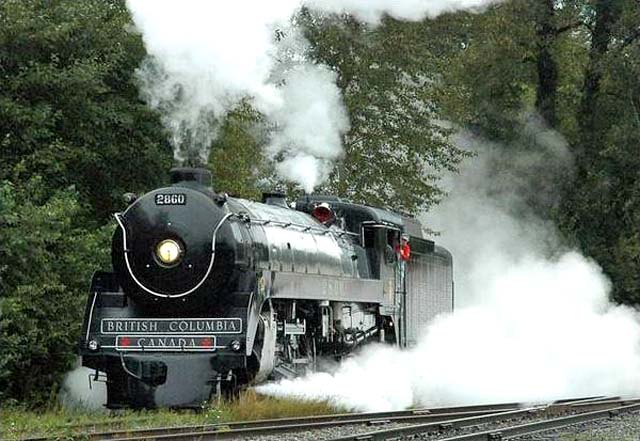
2012
|


Canadian Pacific 2860 at Squamish - Date/Photographer unknown.
22 November 2012
Symphony of Motion
Squamish British Columbia - She hints at her health through her sounds.
Chhuka, chhuka, chhuka, chhuka.
Swirling hisses churn around her cast-iron parts as she hauls the clanking and squealing cars behind her. Pillows of steam, acidic smells, and a fire heating
5,000 gallons of water all speak to her existence. It's her language, said Mark Liggins.
"It's like she's talking to you," the train enthusiast said. "That is what really makes it worthwhile."
Liggins has been around trains all his life. His family's history runs parallel to that of the railway. In Edmonton, Liggins's father worked in the CN Rail
shops. His grandfather was an engineer and fire man on steam engines, reading the colour of the plumes and gauging whether the roaring flames needed to be
stoked or left alone.
Liggins first sat behind the controls of Royal Hudson locomotive number 2860 during Expo '86. It wasn't a big move. He shifted the engine a few hundred yards
at the steam exhibit. But it was enough to get him hooked.
Before the Hudson, Liggins's experience in operating locomotives was limited to miniatures, such as the tiny train that loops around his backyard. Although
vastly different in size, operating a miniature steam engine and the real deal is relatively the same, Liggins said. The larger version is just that much more
exhilarating. The experience heightens one's senses, sound, sight, smell, as the engine's parts pump and turn as though they're enchanted.
"It's a symphony of motion."
It's a symphony that came very close to an end for the Royal Hudson. Before she called the West Coast Railway Heritage Park home, and previous to a provincial
tourist initiative that saw her pull a million passengers from North Vancouver to Squamish, she was all but forgotten.
Among the final five Hudsons built for the Canadian Pacific Railway (CPR) in June 1940, 2860 spent most of her career on the CPR mainline between Revelstoke
and Vancouver. She was the oil-burning sibling of the original coal-burning Hudson class built in 1929 by the Montreal Locomotive Works.
The engines' title were handed to them by the New York Central Railroad, the company that first used the 4-6-4 wheel arrangement and christened them after the
Hudson River. In 1939, they became the first and only locomotives outside of Great Britain to earn the "royal" designation. King George VI and Queen
Elizabeth were hauled from coast to coast by Hudson 2850 on their first visit to Canada. It was an impressive feat. For maintenance reasons, during that era it
was common practice to change engines several times during long trips.
But by 1958, the Hudson was outdated. Steam engines were quickly being replaced by modern diesels, as fuel prices and the mechanical bills relegated them to
the status of dinosaurs, said Don Evans, president of the West Coast Railway Association. The Hudson needed many times the crew complement to keep her going
than did a diesel engine, he noted.
With her costs too high, 2860 was assigned to the scrap line, joining approximately 1,000 other steam engines. There she waited for half a decade for her body
to be cut up, melted, and re-purposed into another product. But fate had a different plan for the engine. In 1961, 2860 was rediscovered by a Vancouver-based
group of railway enthusiasts who toured the banished trains.
"They were pretty surprised," Evans said.
The train was brought back to Vancouver and housed at the Canadian Pacific Railway's Vancouver roundhouse. In the 1970s, backed by then B.C. Premier Dave
Barrett, the Hudson was put into service transporting tourists from North Vancouver to Squamish. Provincial reports estimate the Hudson pumped $300 million
into the economy.
Her fire was once again subbed out in 1999, when the steam engine failed inspection. Three years later, the government of the day decided the required fixes
had to wait. That's when Squamish stepped in, Evans said. Working together, the West Coast Railway Association and the District of Squamish rallied for the
train to call Squamish home. It belonged here, said Corinne Lonsdale, who was mayor at the time.
"It was just a piece of Squamish history," she said.
Lonsdale, Evans, and then-councillor Wendy Magee, headed to Victoria to acquire the Hudson for the heritage park. It took some doing, Lonsdale recalled, at
least a good part of a year. But by May 2002, they had their wish.
"The railroad is our heritage in this community," she said.
Today, the Hudson faces another hurdle. Although the boiler only has 300 hours on it, every five years the provincial government mandates a full boiler
inspection and re-certification. This requires it to be disassembled, tested, checked, and re-assembled, a process that will cost more than $100,000.
"That's were the issue lies," Evans said.
Currently, the park has its hands full, he noted. It's dealing with raising funds to repair damage done from a rash of copper thefts at the park last summer.
By next year, Evans said the focus will shift to the Hudson and hopefully, with a bit of elbow grease and cash, the old gal will be steaming again.
"When you see the Hudson going, all its parts in motion, it looks and sounds like it is alive and breathing," Evans said.
To donate or for more information visit www.wcra.org.
Rebecca Aldous.

|


|
Vancouver Island
British Columbia
Canada
|
|